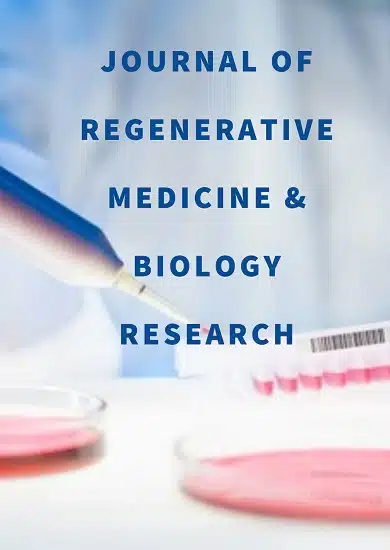Review Article | Vol. 6, Issue 1 | Journal of Regenerative Medicine and Biology Research | Open Access |
Osteoarthritis: Treatment Exploration Using Stem Cells
Eva Clinton1, Vincent S Gallicchio1*
1Department of Biological Sciences, College of Science, Clemson University, Clemson, SC, USA
*Correspondence author: Vincent S Gallicchio, Department of Biological Sciences, College of Science, Clemson University, Clemson, SC, USA; Email: [email protected]
Citation: Clinton E, et al. Osteoarthritis: Treatment Exploration Using Stem Cells. J Reg Med Biol Res. 2025;6(1):1-9.
Copyright© 2025 by Clinton E, et al. All rights reserved. This is an open access article distributed under the terms of the Creative Commons Attribution License, which permits unrestricted use, distribution, and reproduction in any medium, provided the original author and source are credited.
| Received 11 March, 2025 | Accepted 25 March, 2025 | Published 01 April, 2025 |
Abstract
Osteoarthritis is a degenerative disease of the cartilage that affects millions. Its pathology is characterized by catabolic and anabolic factors that can be modified due to age, weight and genetics to increase the severity of deterioration. Current standards of care may manage symptoms, but there is currently no proven treatment of osteoarthritis to reverse degeneration and build back the ECM. Due to this, stem cells have been investigated as a potential therapy. This is because of their unique abilities to differentiate into many cell types and even regenerate tissue. Mesenchymal stem cells have been targeted specifically because of their high reproduction rate and many other important factors. Studies done have concluded that there are statistically significant benefits in treating osteoarthritic joints with mesenchymal stem cells derived from adipose tissue and umbilical cord tissue as well as synovial. Although these benefits have been recorded, it is still imperative that further studies be conducted to test the longevity of the treatment and its possible negative side effects.
Keywords: Osteoarthritis; Mesenchymal Stem Cells; Mesenchymal Stem Cell Exomes; Cartilage Degradation
Abbreviations
AD-MSC: Adipose Mesenchymal Stem Cell; BM-MSC: Bone Marrow Mesenchymal Stem Cells; ECM: Extracellular Matrix; MSC: Mesenchymal Stem Cell; SMSC: Synovial Mesenchymal Stem Cell; SMSC-Exos: Synovial Mesenchymal Stem Cell Exomes; SMSC-140-Exos: Synovial Mesenchymal Stem Cell Exosomes-140; UC-MSC: Umbilical Cord Mesenchymal Stem Cell; WOMAC: Western Ontario and McMaster Universities Osteoarthritis Index
Introduction
Osteoarthritis is a subtype of arthritis and is the leading cause of disability for older adults in the United States [1]. This disease leads to joint pain, loss of function and overall, a decrease in quality of life for millions of people which will only increase. It is approximated that 300 million people across the globe and 30.8 million people in America alone are affected by this degenerative disease [1]. It can be characterised and defined by multiple different factors that associate to cause pain and other symptoms that correlate to a damaged articular cartilage, joint margins and the bones in the joint as well [2]. Its severity can be classified into three stages including early middle and late severity (Table 1, Fig. 1) [3].
Early Stage Sharp, predictable pain, normally brought about by a mechanical injury that after sometimes limits high-impact activities. Effect on function may be insignificant. |
Middle Stage (Mild-Moderate) More frequent pain with unpredictable episodes of stiffness. The pain starts to impede daily lives activity. |
Advanced Stage Constant throbbing pain, interspersed by short episodes of mostly unpredictable, intense, excruciating pain that severely hinder functions. |
Table 1: Osteoarthritic stages of pain [3].
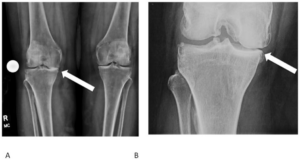
Figure 1: (A) Radiograph comparison between right osteoarthritic knee (arrow) and the left knee; (B) Right knee magnified to see the medial joint space narrowing and osteophyte formation [4].
Some symptoms of osteoarthritis include pain, stiffness, coarse crepitus, bony enlargement, joint-line tenderness and locomotor restriction [5]. It can also be described as a mechanically driven disease that is more prevalent in obese populations. Due to this, as obesity continues to increase, osteoarthritis will as well [6]. Obesity, in addition to age and genetics, affects the mechanical strain applied to the joint which impedes its ability to repair over time [6]. Trauma to the knee has also been found to increase the risk of osteoarthritis in patients [7]. The pathology of osteoarthritis is often thought to be associated with inflammation of the likes seen in rheumatoid arthritis, but it is distinct. While in rheumatoid arthritis the primary leukocytes found in the synovial fluid of the joint are monocytes, in osteoarthritis they are found to be neutrophils [6].
Pathology of Osteoarthritis
The pathology of osteoarthritis can be organized into six different aspects. These are cartilage matrix degradation, inflammation, synovial fibrosis, failed cartilage repair, bone remodelling and aging. In healthy cartilage, anabolic versus catabolic activity is balanced. In osteoarthritic joints, the degradation of the cartilage predominates over regeneration, which eventually leads to cartilage loss [8]. The breakdown of collagen II and aggrecan are the primary cause of cartilage matrix degradation as they are key to the structural integrity of the cartilage and its ability to resist compression over time. This is thought to be done by matrix metalloproteinases for collagen II and adamalysins with thrombospondin motifs for aggrecan. Inflammation was once not considered to be part of the pathology of osteoarthritis but is now recognized as a consistent component found in patients. This is seen by the increase in inflammatory cells and vascularization to the synovium along with hypertrophy and hyperplasia of the synovial lining, which all contribute to inflammation of the joint. While the primary focus of osteoarthritis surrounds degradation of the cartilage, disorders of the synovial membrane in the fibrotic, hyperplastic and detritus-rich forms can drive pathology as well [9]. The cartilage degradation that characterizes osteoarthritis can repair itself, but only if the mechanical strain that is causing the detrimental environment to the joint is removed. For instance, if the joint were to be reinforced above and below, it has been confirmed by MRI imaging that regeneration of this cartilage can be seen. Because of this, targeting mechanical strain of the joint and changing the damaging environment can be key in its repair [9]. One of the earliest predictors of osteoarthritis is bone remodelling of the thin subchondral bone plate and the subchondral trabecular bone by osteoclasts and osteoblasts. This bone gives structural and vascular support as well as shape to the cartilage so when the bone is remodelled and broken down the cartilage suffers as well. The last area of osteoarthritis pathology is aging. It is not a surprise that as age increases, chances of osteoarthritis increase as well and this is due to nine possible factors that deal with the genome instability, telomere attrition, epigenetic alteration, loss of proteostasis, deregulated nutrient sensing, mitochondrial dysfunction, stem cell exhaustion, cellular senescence and altered intracellular communication (Fig. 2) [9].
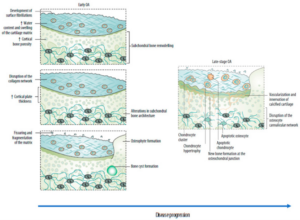
Figure 2: Figure representing the early versus late-stage tissue of osteoarthritis [10].
Standard of Care
The current standard of care for osteoarthritis is categorized into pharmacological treatments and non-pharmacological treatments. Pharmacological treatments include, stem cell therapies, NSAIDs and hyaluronan injections. There is no effective treatment of osteoarthritis currently, only ways to help manage it that may also cause negative side effects. Non-pharmacological treatments include joint replacement, aerobic exercise, nutritional supplements and weight loss, which can help reduce mechanical strain. Joint replacement and surgery are used as last resorts in severe cases. These do not reverse osteoarthritis progression, but they do help manage pain and increase function of the joint [11].
Stem cells are potentially a good candidate for treatment of osteoarthritis due to their regenerative nature. Osteoarthritis is a degenerative disease of the joint cartilage in addition to numerous other factors and stem cell therapy could potentially reverse and treat this degeneration rather than manage the symptoms [12].
Discussion
Mesenchymal Stem Cells
Stem cells from different areas of the body are prone to differentiate into more specialized functions depending on where they are harvested and what characteristics they have. For this reason, specific stem cells are harvested for potential osteoarthritis treatments. Most stem cells used in treatment of osteoarthritis are mesenchymal stem cells. This is due to multiple factors that these cells possess that are needed for regenerative medicine. These include colony formation and the ability to survive in testable and observable conditions, surface phenotypes that allow them to be identified, plasticity and differentiation potential and finally increased telomerase activity. These stem cells also have extracellular vesicles also referred to as exomes that may be responsible for much of the therapeutic effect of MSC’s [13]. This increased telomerase activity decreases cell senescence giving these cells increased ascendancy in therapies for age-related diseases [14]. Mesenchymal stem cells exhibit the ability to differentiate into multiple different cell types in the joint from a single cell, which is a crucial function. These stem cells lack MHC-II and possess low levels of MHC-I, which are cell surface proteins that aid in determining the immune response to antigens. Because of this quality, mesenchymal cells have a decrease in triggered immune response when allogeneic transplantation takes place for treatments [15]. Mesenchymal stem cells are harvested from primarily three different sources. These are the bone marrow, adipose tissues and umbilical cord. The three different areas pose unique characteristics. BM-MSCs are the most used due to their quick reproduction, accessibility, differentiation and reduced allergen response. Adipose tissue MSCs have even more rapid reproduction then BM-MSCs making them another good candidate. Umbilical cord MSCs could be used because of their exceeding immunomodulatory characteristics when compared with the BM-MSCs [16]. Other sources for mesenchymal stem cells also include brain, lung, synovium, synovial fusion and peripheral blood [17].
Mesenchymal Stem Cell Therapy for Osteoarthritis
One study investigates exomes produced from mesenchymal stem cells and their potential effects on osteoarthritis. In this study, synovial MSCs are used to extract exomes to use in rats. It is found that exomes facilitate in cartilage formation through chondrocyte enhancement in many ways, prevent ECM degradation, modulate immunoprotective signals, inhibit cell senescence and proinflammatory mediators, protect cells from oxidative stress and regenerate cartilage [15]. Exomes are also referred to as extracellular vesicles that are released by cells to perform biological changes which include promoting the regeneration of cartilage tissue (Fig. 3) [13].
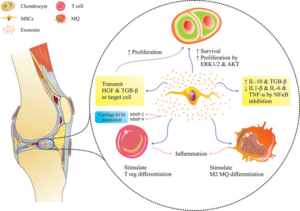
Figure 3: Exomes of mesenchymal stem cells and their effect on cartilage regeneration. They stimulate production of the ECM and block immune response to halt cartilage degradation and stimulate chondrocytes [18].
The SMSC-Exos increased the migration and proliferation of the chondrocytes but also inhibited ECM formation. To prevent this, modifications were made to the SMSC-Exos in the creation of SMSC-140-Exos, so it retained its ability to enhance chondrocyte proliferation while also no longer inhibiting the production of the ECM. The group treated with no SMSC-Exos or SMSC-140-Exos had severe deterioration of the joint cartilage. Type II collagen and aggrecan had decreased in the ECM. The group treated with the SMSC-Exos without modification had deterioration but not as severe as the control group treated with no SMSC-Exos. The cartilage matrix was thin and aggrecan production was low. Finally, the group treated with the SMSC-140-Exos showed mild joint wear, no decrease in aggregate production and only a slightly thinner ECM than in the normal group with no osteoarthritis (Fig. 4) [19].
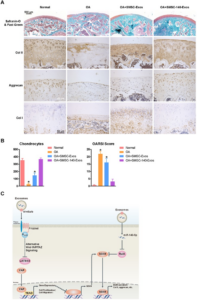
Figure 4: (A) Evidence that SMSC-Exos showed prevention of osteoarthritis through histological analysis; (B) Chondrocyte counts and OARSI score (C) Mechanism of SMSC-140-Exos in prevention of osteoarthritis [20].
Clinical Evidence
While rats are integral for understanding the processes of disease treatments and mechanisms, clinical trials are the only way to test if a therapy is effective. A randomized, controlled and double-blind trial tested the effects and safety of mesenchymal stem cells. In this trial, UB-MSCs were tested against hyaluronic acid injections in osteoarthritic knees. Both injections were done intra-particularly with repeated dosing. The target population was 40-65 years of age. It was found that after six months the patient group was found to have significant improvements in WOMAC scores compared to the hyaluronic acid injection group. In addition to this, the safety of the UC-MSCs showed no concerns to be aware of (Fig. 5) [20].
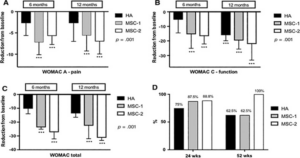
Figure 5: Shown above is the (A) WOMAC pain subscale compared to baseline scored; (B) WOMAC-C function subscale compared to baseline scores; (C) Total WOMAC compared with baseline scores; (D) OMERAC-OARSI Responder Index Criteria [11].
In the next trial MSCs were derived from adipose tissue to be used in a patient group ranging from 18-75 years of age who were eligible. Patients were blindly assigned to either a saline injection or the AD-MSC injection. They were followed up at 1, 3 and 6 months after to assess their efficacy and safety evaluations. It was found at the 6 months that there was a 55% reduction in WOMAC scores while the control group showed minimal statistically significant change. They also assessed radiological outcomes of the joint space width of medial and lateral compartment which did not change in either group significantly in the 6 months. The cartilage defect did not significantly change in the MSC group but in the control, it worsened (Fig. 6,7) [21-23].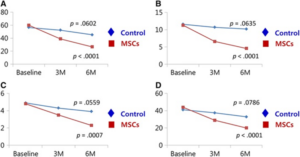
Figure 6: This displays the changes in WOMAC scores in the 6-month period between MSC groups and control groups. (A) Total WOMAC score (B) Pain sub score (C)Stiffness sub score (D) Function sub score [21].
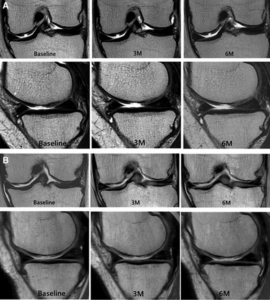
Figure 7: MRI imaging of baseline 3 months and 6 months. (A) Coronal and sagittal images of the medial femoral and tibial condyles with injection of AD-MSCs before, 3 months and 6 months. (B) Coronal and sagittal images of the medial femoral and tibial condyles with injection of saline before, 3 months and 6 months which significantly increased by the 6-month mark [21].
While one study used umbilical cord derived mesenchymal stem cells and another used adipose, the studies concluded with positive findings in a short period of time. Due to this short period, longer studies will need to be done to test the longevity of the treatment and its effects on patient treatment.
Challenges In Mesenchymal Stem Cell Therapy
Many clinical trials have been small cohorts of patients, so it is difficult to assess the risks of MSC in therapeutic use. Some complications found have been intramyocardial and vascular calcification due to unrestrained proliferation, modified autography regulation and enhanced senescence. Elderly donors of stem cells have shown to produce an inflammatory response in the recipients as well [22]. Mesenchymal stem cell therapy requires further research into potential risks.
Conclusion
The unique characteristic of stem cells, particularly mesenchymal stem cells, allows for differentiation into chondrocytes to regenerate the ECM and cartilage of osteoarthritic joints. In addition to this, exomes released by stem cells also stimulate regeneration of osteoarthritic joint cartilage. Osteoarthritis pathology is characterized by catabolism of the cartilage exceeding its regeneration which makes the regenerative qualities of stem cells a promising future for the treatment of this disease. The results of SMSCs treated in rats concluded that SMSC-140- Exos prevented further degradation of the cartilage and progression of the disease while the SMSC-Exos had limited therapeutic effects. This shows the potential therapeutic benefits of exomes derived from stem cells, while further studies will need to be performed in clinical settings. In the clinical trials, both the UC-MSCs and AD-MSCs showed statistically significant results in the WOMAC scores of patients 6 months post injections. While this proves the benefits of mesenchymal stem cells in a clinical trial, further studies should be performed to test the longevity of these results. Adverse effects post 6 months should also be investigated although none were found initially.
Conflict of Interests
The authors declare no conflict of interest in this publication.
Ethical Approval
This review article does not contain any studies with human participants or animals performed by any of the authors.
References
- Driban JB, Vincent HK, Trojian TH, Ambrose KR, Baez S, Beresic N, et al. Evidence review for preventing osteoarthritis after an anterior cruciate ligament injury: an osteoarthritis action alliance consensus statement. J Athletic Training. 2023;58(3):198-219.
- Kohn MD, Sassoon AA, Fernando ND. Classifications in brief: Kellgren-Lawrence classification of osteoarthritis. Clinical Orthopaedics and Related Research®. 2016;474:1886-93.
- Yunus MH, Nordin A, Kamal H. Pathophysiological perspective of osteoarthritis. Medicina. 2020;56(11):614.
- Braun HJ, Gold GE. Diagnosis of osteoarthritis: Imaging. Bone. 2012;51(2):278-88.
- Harrell CR, Markovic BS, Fellabaum C, Arsenijevic A, Volarevic V. Mesenchymal stem cell-based therapy of osteoarthritis: Current knowledge and future perspectives. Biomedicine Pharmacotherapy. 2019;109:2318-26.
- Vincent TL. Of mice and men: converging on a common molecular understanding of osteoarthritis. The Lancet Rheumatology. 2020;2(10):e633-45.
- Punzi L, Galozzi P, Luisetto R, Favero M, Ramonda R, Oliviero F, et al. Post-traumatic arthritis: Overview on pathogenic mechanisms and role of inflammation. RMD Open. 2016;2(2):e000279.
- Mueller MB, Tuan RS. Anabolic/catabolic balance in pathogenesis of osteoarthritis: identifying molecular targets. PM&R. 2011;3(6):S3-11.
- Vincent TL, Alliston T, Kapoor M, Loeser RF, Troeberg L, Little CB. Osteoarthritis pathophysiology: therapeutic target discovery may require a multifaceted approach. Clin Geriatric Medicine. 2022;38(2):193-219.
- Coaccioli S, Sarzi-Puttini P, Zis P, Rinonapoli G, Varrassi G. Osteoarthritis: new insight on its pathophysiology. J Clin Medicine. 2022;11(20):6013.
- Mohammadinejad R, Ashrafizadeh M, Pardakhty A, Uzieliene I, Denkovskij J, Bernotiene E, et al. Nanotechnological strategies for osteoarthritis diagnosis, monitoring, clinical management, and regenerative medicine: recent advances and future opportunities. Current Rheumatology Reports. 2020;22:1-7.
- Ebrahimi A, Ahmadi H, Ghasrodashti ZP, Tanideh N, Shahriarirad R, Erfani A, et al. Therapeutic effects of stem cells in different body systems, a novel method that is yet to gain trust: A comprehensive review. Bosnian J Basic Medical Sciences. 2021;21(6):672.
- Park KS, Bandeira E, Shelke GV, Lässer C, Lötvall J. Enhancement of therapeutic potential of mesenchymal stem cell-derived extracellular vesicles. Stem Cell Research and Therapy. 2019;10:1-5.
- Vasanthan J, Gurusamy N, Rajasingh S, Sigamani V, Kirankumar S, Thomas EL, et al. Role of human mesenchymal stem cells in regenerative therapy. Cells. 2020;10(1):54.
- Vadhan A, Gupta T, Hsu WL. Mesenchymal stem cell-derived exosomes as a treatment option for osteoarthritis. Int J Molecular Sciences. 2024;25(17):9149.
- Zhu C, Wu W, Qu X. Mesenchymal stem cells in osteoarthritis therapy: a review. Am J Translational Research. 2021;13(2):448.
- Cai H, Guo H. Mesenchymal stem cells and their exocytotic vesicles. Int J Molecular Sciences. 2023;24(3):2085.
- Malekpour K, Hazrati A, Zahar M, Markov A, Zekiy AO, Navashenaq JG, et al. The potential use of mesenchymal stem cells and their derived exosomes for orthopedic diseases treatment. Stem Cell Reviews and Reports. 2022;18(3):933-51.
- Tao SC, Yuan T, Zhang YL, Yin WJ, Guo SC, Zhang CQ. Exosomes derived from miR-140-5p-overexpressing human synovial mesenchymal stem cells enhance cartilage tissue regeneration and prevent osteoarthritis of the knee in a rat model. Theranostics. 2017;7(1):180.
- Matas J, Orrego M, Amenabar D, Infante C, Tapia-Limonchi R, Cadiz MI, et al. Umbilical cord-derived Mesenchymal Stromal Cells (MSCs) for knee osteoarthritis: Repeated MSC dosing is superior to a single MSC dose and to hyaluronic acid in a controlled randomized phase I/II trial. Stem Cells Translational Medicine. 2019;8(3):215-24.
- Lee WS, Kim HJ, Kim KI, Kim GB, Jin W. Intra-articular injection of autologous adipose tissue-derived mesenchymal stem cells for the treatment of knee osteoarthritis: A phase IIb, randomized, placebo-controlled clinical trial. Stem Cells Translational Medicine. 2019;8(6):504-11.
- Lee WS, Kim HJ, Kim KI, Kim GB, Jin W. Intra-articular injection of autologous adipose tissue-derived mesenchymal stem cells for the treatment of knee osteoarthritis: A phase IIb, randomized, placebo-controlled clinical trial. Stem Cells Translational Medicine. 2019;8(6):504-11.
- Baranovskii DS, Klabukov ID, Arguchinskaya NV, Yakimova AO, Kisel AA, Yatsenko EM, et al. Adverse events, side effects and complications in mesenchymal stromal cell-based therapies. Stem Cell Invest. 2022;9:7.
Author Info
Eva Clinton1, Vincent S Gallicchio1*
1Department of Biological Sciences, College of Science, Clemson University, Clemson, SC, USA
*Correspondence author: Vincent S Gallicchio, Department of Biological Sciences, College of Science, Clemson University, Clemson, SC, USA;
Email: [email protected]
Copyright
Eva Clinton1, Vincent S Gallicchio1*
1Department of Biological Sciences, College of Science, Clemson University, Clemson, SC, USA
*Correspondence author: Vincent S Gallicchio, Department of Biological Sciences, College of Science, Clemson University, Clemson, SC, USA;
Email: [email protected]
Copyright© 2025 by Clinton E, et al. All rights reserved. This is an open access article distributed under the terms of the Creative Commons Attribution License, which permits unrestricted use, distribution, and reproduction in any medium, provided the original author and source are credited.
Citation
Citation: Clinton E, et al. Osteoarthritis: Treatment Exploration Using Stem Cells. J Reg Med Biol Res. 2025;6(1):1-9.

